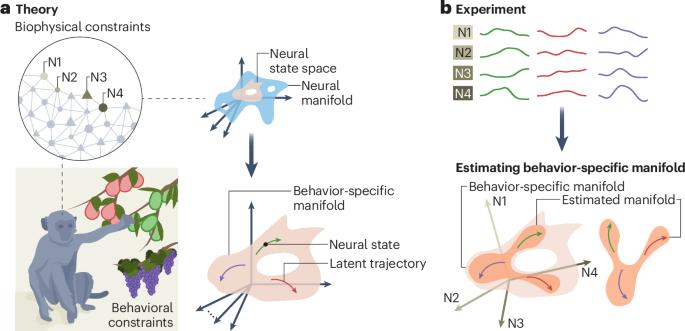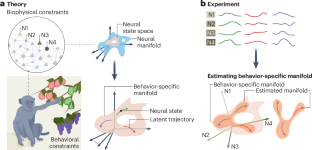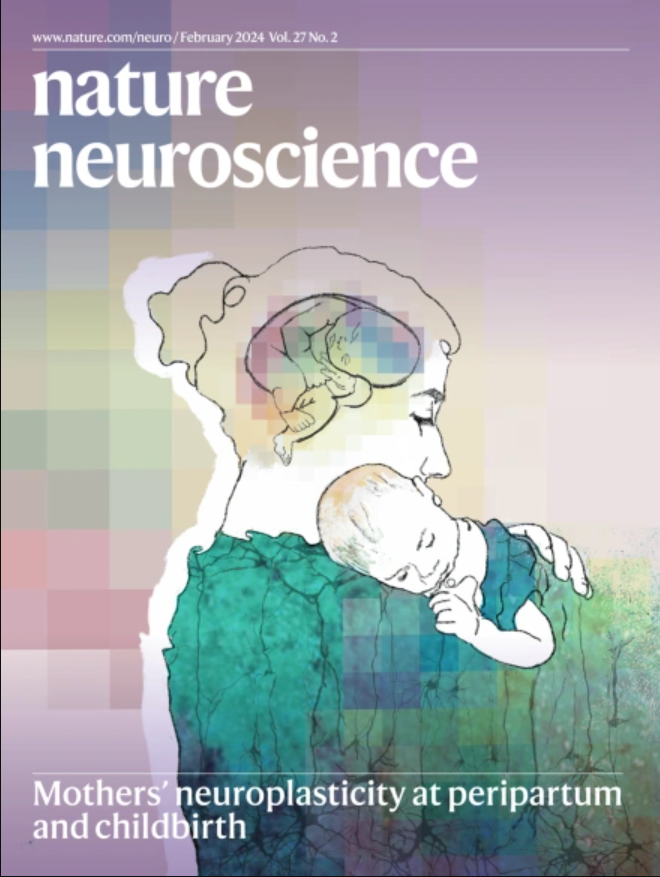大脑的神经歧见
IF 20
1区 医学
Q1 NEUROSCIENCES
引用次数: 0
摘要
动物的行为源于横跨整个大脑的神经群的协调活动。来自越来越多的大脑区域、行为和物种的大神经群的活动呈现出低维结构。我们假设这种结构是神经流形的结果。神经流形是对有意义的生物实体的数学描述:给定神经回路的内在(例如,连接)和外在(例如,行为)约束,神经元群体可能的集体状态。在这里,我们探讨了神经流形和行为之间的联系,并讨论了神经流形框架可以为大脑功能提供的见解。最后,我们探讨了这个框架中现有的概念差距,并讨论了它们在构建脑功能综合观点时的意义。因此,我们将神经流形定位为描述大脑如何产生行为的关键框架。本文章由计算机程序翻译,如有差异,请以英文原文为准。


A neural manifold view of the brain
Animal behavior arises from the coordinated activity of neural populations that span the entire brain. The activity of large neural populations from an increasing number of brain regions, behaviors and species shows low-dimensional structure. We posit that this structure arises as a result of neural manifolds. Neural manifolds are mathematical descriptions of a meaningful biological entity: the possible collective states of a population of neurons given the constraints, both intrinsic (for example, connectivity) and extrinsic (for example, behavior), to the neural circuit. Here, we explore the link between neural manifolds and behavior, and discuss the insights that the neural manifold framework can provide into brain function. To conclude, we explore existing conceptual gaps in this framework and discuss their implications when building an integrative view of brain function. We thus position neural manifolds as a crucial framework with which to describe how the brain generates behavior. Recent advances in neuroscience have revealed how neural population activity underlying behavior can be well described by topological objects called neural manifolds. Understanding how nature, nurture and other factors shape neural manifolds could illuminate new avenues for defining mechanisms and interventions.
求助全文
通过发布文献求助,成功后即可免费获取论文全文。
去求助
来源期刊

Nature neuroscience
医学-神经科学
CiteScore
38.60
自引率
1.20%
发文量
212
审稿时长
1 months
期刊介绍:
Nature Neuroscience, a multidisciplinary journal, publishes papers of the utmost quality and significance across all realms of neuroscience. The editors welcome contributions spanning molecular, cellular, systems, and cognitive neuroscience, along with psychophysics, computational modeling, and nervous system disorders. While no area is off-limits, studies offering fundamental insights into nervous system function receive priority.
The journal offers high visibility to both readers and authors, fostering interdisciplinary communication and accessibility to a broad audience. It maintains high standards of copy editing and production, rigorous peer review, rapid publication, and operates independently from academic societies and other vested interests.
In addition to primary research, Nature Neuroscience features news and views, reviews, editorials, commentaries, perspectives, book reviews, and correspondence, aiming to serve as the voice of the global neuroscience community.
 求助内容:
求助内容: 应助结果提醒方式:
应助结果提醒方式:


